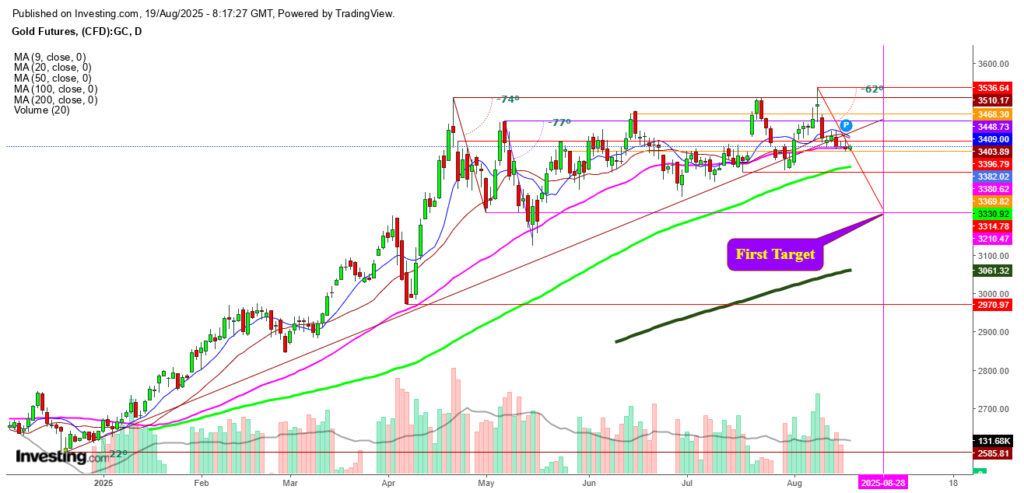As Monday dawned, a palpable tension gripped the trading floors, manifesting particularly in the domain of gold futures. These futures saw a modest uptick after encountering formidable resistance at $3,396. This was shortly after they had tested a lower threshold at $3,370, which was tantalizingly close to the immediate support level – the 50-day moving average (DMA) at $3,380. The day concluded with the chart depicting a bearish hammer formation, signaling potential downward pressure. Despite an attempt at reversal on Tuesday, the persistence of gold futures below this critical 50 DMA augured a continued phase of vulnerability. This scenario was further compounded by geopolitical uncertainties, primarily hinging on the U.S. President’s ability to broker a ceasefire between Russia and Ukraine.
The prospect of peace in Ukraine, particularly one that might entail European nations bearing some burden, looms large over the gold futures market. Should such an agreement come to fruition, we may anticipate a sell-off in gold futures. This is especially likely if the futures continue to linger below the immediate support, which may soon transform into a formidable resistance zone. This potential shift in market dynamics coincides with U.S. President Donald Trump’s diplomatic engagements with his Russian counterpart, Vladimir Putin. Trump’s initiation of dialogue, inclusive of a proposal for a meeting with Ukraine’s Volodymyr Zelensky, followed by a tripartite discussion, injects a sliver of hope for negotiations – an outlook that may not bode well for gold bulls.
This unfolding saga is particularly intriguing in the context of the Federal Reserve’s annual symposium in Jackson Hole, Wyoming. Here, anticipation is rife regarding Fed Chair Jerome Powell’s discourse on the economic horizon and the central bank’s policy framework amidst burgeoning concerns of surging stagflation fueled by recent U.S. tariff impositions.
Turning our gaze to the technical aspect, gold futures demonstrated volatility within a constrained range subsequent to a sharp decline that saw them breach the 50 DMA support at $3,380, albeit momentarily rallying to challenge the resistance at $3,396. This oscillation culminated in a bearish hammer pattern. Despite a nascent recovery on Tuesday from the day’s nadir at $3,370, gold futures strove to reclaim ground above the 50 DMA. Failure to do so might consolidate this level as a significant barrier, particularly if this stance persists into Wednesday.
Should the gold futures embark on a descent towards the 100 DMA at $3,330, a recuperation could be on the cards. However, breaching this threshold may set the stage for the futures to test the next bastion of support at the 200 DMA, positioned at $3,061, potentially unfolding before August 28, 2025.
Intricately woven into this narrative is a broader tapestry encapsulating not only the immediate technical indicators and fluctuations but also the geopolitical undercurrents influencing market sentiment. The discourse around gold futures is emblematic of the complex interplay between economic policy, international diplomacy, and market dynamics. It underscores the criticality of astute observation and informed analysis in navigating the uncertain terrain of global finance.
As this situation continues to evolve, market participants and observers alike are poised on the brink of potential shifts that could redefine not only the course of gold futures but also the broader economic landscape. Amidst these considerations, it is paramount for stakeholders to tread with caution, grounding their decisions in a comprehensive understanding of both the micro and macroeconomic variables at play.
Disclaimer: This analysis is intended solely for educational and informational purposes. Readers are advised to conduct their own research and consult with professional financial advisors before making any investment decisions in the gold futures market.



